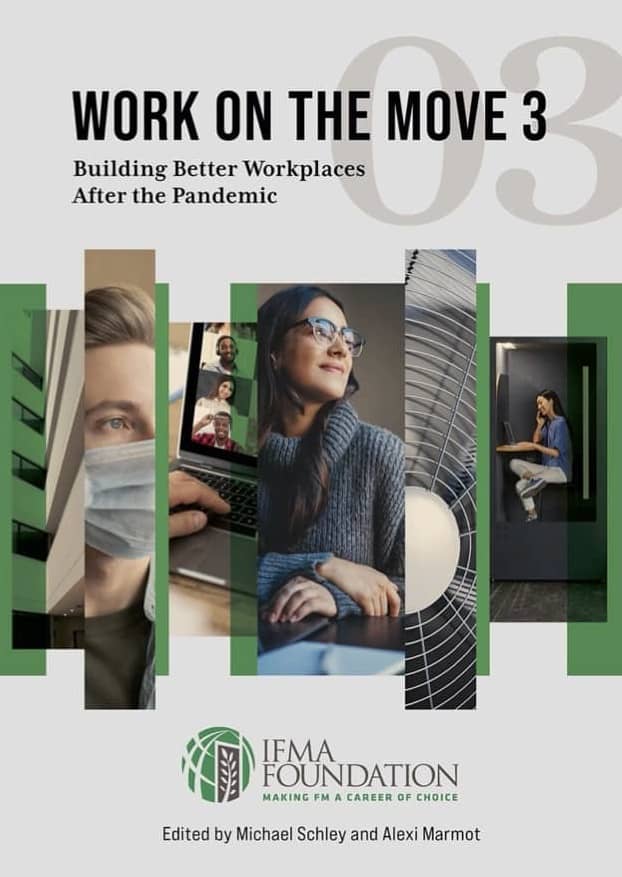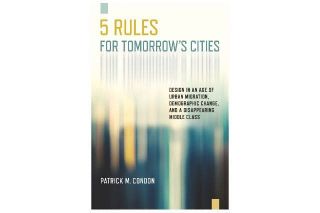
www.buildingsandcities.org/insights/reviews/building-better-workplaces.html
Work on the Move 3: Building Better Workplaces After the Pandemic
Edited By Michael Schley and Alexi Marmot. IFMA, 2021, ISBN: 9781737903222
Chiara Tagliaro (Politecnico di Milano) reviews this book which considers the nature and practices for the post-Covid workplace as a hybrid of virtual and on site activities.

If it's true that "good things come in threes", then Work on the Move 3 is no exception, coming after Work on the Move in 2011 and Work on the Move 2 in 2016. Both the previous books sponsored by the IFMA Foundation were widely appreciated for helping facility managers and other workplace professionals around the globe make sense of the progressive evolution of work. This latest volume promises to be the right complement to the preceding editions by problematizing the role played by Covid-19 in the context of work and workplaces, including implications at the corporate real estate level.
Edited by Michael Schley and Alexi Marmot, the text reflects both their professional expertise and academic profile. This book has a unique quality of being written in clear, accessible language and narrative, whilst providing solid support for its arguments based on data from white and grey literature.
The main thread develops around the idea that work is going to be hybrid, meaning that part of the activities will be performed on site and others will be virtual. The office is expected to become primarily a place for collaboration, interaction, and innovation, while employees will navigate across different workplaces at different times of the day. In this scenario, facilities management (FM) plays a fundamental role, both as an enabler of the changing role of the office and itself as an evolving organization.
The only way to successfully adapt to this new hybrid mode is the adoption of a convincing workplace strategy built on a business case, which will be the mission of 'workplace management'. A valuable contribution of the book is in the attempt to disseminate one of the few, if not the only, available definitions of workplace management (see p. 17). Another important contribution is that it explains how to actually embrace a workplace management mindset.
The narrative guides the reader to
embrace this new mindset. This is achieved by describing a path for the
creation of a workplace experience. (This
is in contrast to a traditional approach which focuses first on design issues and
then on issues such as people's well-being, sustainability, the provision of
services, tech choices, etc.) Instead, this book places the design phase at
the end. This is the correct approach when one needs to completely rethink the
whole organization of work and not only the arrangement of a handful of
workstations.
The sequence of the chapters unfolds from considerations about people's health and wellbeing at work, to planetary health and sustainability, diversity, equity and inclusion in facility management, technology and smart workplaces, innovations in real estate and workplace localization, and finally dynamic provisioning of services in the workplace. All this occurs before introducing novel approaches to designing the post-pandemic workplace.
Referring to the classic process of workplace creation and management, the journey proposed in this book starts with first principles. This is likely to be the most attractive journey for workplace visionaries and the most effective to be taken in the pandemic's aftermath, when everything needs to be reconsidered from their roots. Both workplace practitioners and researchers are offered a meaningful collection of stimulating ideas followed by case studies for a future hybrid work mode and the evolution of organizations, workspaces and services that gravitate around that. Yet, the book does even more.
The sensitivity and qualification of the authors is evident in a rare attention to terminology, that is especially appreciated in a time when linguistic confusion is diffused due to an overwhelming sprout of buzzwords. The book provides original concepts that, more than simple hapax legomenon, deserve to become neologisms. These include: placefulness and workplaces worth the journey, which are both effective expressions anticipating some of the key characteristics of future workplaces. The first term draws on the idea of mindfulness and peacefulness that should be integrated into future neighbourhoods for a more balanced life and workstyle. The second term reminds us that workplaces will increasingly be elective places, thus they need to offer exceptional quality to justify the time and resources taken to reach them. Both these principles go under the umbrella concept of wellworking, which would encompass health, hygiene, well-being and flourishing in the digital and physical workplace.
How could all this possibly come true? By considering 'design' as a verb rather than a noun, in order for it to be a problem-solving process more than a simple end product. Workplace management itself and the concept of experience find a definition in the volume. It helps consider these terms as evolving practices instead of well-defined acts or confined events. As the workplace evolves, so does the vocabulary that describes it.
If spoilers don't disturb the reader, one could jump first to the case studies that are presented in the last 100 pages. Eight companies (from Australia, Austria, Canada, US, and New Zealand) from different sectors (public administration, health care financial services, technology, etc.) present their most recent workplace changes. All the cases are recounted based on a description of the organization and the country where the case is located; an overview of the post-Covid landscape; the business drivers shaping the approach to the workplace; the workplace strategy and solution complemented by people strategies (change management, policies and training for adaptation), technology strategies, and design/environment strategies; desired impact to business and measurement of success; and the key learning and advice to others.
If readers go back to the beginning of the text, they would realize that among the common drivers of a workplace change are the attraction and retention of talent, reducing costs, accounting for "environmental, social and governance" (ESG), and the desire to align culture and create an equitable work environment. Companies are looking to enhance the organizational culture through the workplace, which encompasses increasing flexibility, boosting the sense of belonging and engagement of the workforce, and augmenting their reputation as a remarkable place for workers and civil society.
The idea of hybrid work is fully embraced by all the case studies. Strategies entail the creation of neighbourhoods, partnerships with third spaces, cafés within the office and a range of other multimodal workspaces. Finally, the implementation of these strategies is obtained thanks to the involvement of employees in participatory processes through pilot projects, surveys, visioning sessions, and strong change management plans including proper community managers.
Last but not least, the name of the different initiatives or workplace models taking place in each company case study often evokes the idea of something on the move: from Workplace of the Future to Dynamic Work, to Playground and Propeller Framework. While flexible work policies will be the norm, within the general framework of a hybrid workplace the future approach is called either 'organic', or 'vibrant'. All terms that recall something alive, the subtle changes that lively entities undergo continuously toward something else.
Not by chance, many of the 19 authors have been involved in the inception and expansion of the Workplace Evolutionaries (WE) initiative. This panel of experienced workplace stakeholders assembled invaluable insights that stem from acute observation of people and organizations at work, before and during Covid-19 as well as beyond. The book's title already anticipates that each chapter addresses lessons from the pandemic. These are especially meaningful because they are integrated into an unfolding pathway that workplaces are already on.
The authors are to be applauded for creating a highly accessible, useful and profound book about the principles and practices surrounding the hybrid workplace. This is a much-needed book and it deserves to be widely read and discussed by all the many stakeholders involved in making workplaces.
Latest Peer-Reviewed Journal Content
Acceptability of sufficiency consumption policies by Finnish households
E Nuorivaara & S Ahvenharju
Key factors for revitalising heritage buildings through adaptive reuse
É Savoie, J P Sapinski & A-M Laroche
Cooler streets for a cycleable city: assessing policy alignment
C Tang & J Bush
Understanding the embodied carbon credentials of modern methods of construction
R O'Hegarty, A McCarthy, J O'Hagan, T Thanapornpakornsin, S Raffoul & O Kinnane
The changing typology of urban apartment buildings in Aurinkolahti
S Meriläinen & A Tervo
Embodied climate impacts in urban development: a neighbourhood case study
S Sjökvist, N Francart, M Balouktsi & H Birgisdottir
Environmental effects of urban wind energy harvesting: a review
I Tsionas, M laguno-Munitxa & A Stephan
Office environment and employee differences by company health management certification
S Arata, M Sugiuchi, T Ikaga, Y Shiraishi, T Hayashi, S Ando & S Kawakubo
Spatiotemporal evaluation of embodied carbon in urban residential development
I Talvitie, A Amiri & S Junnila
Energy sufficiency in buildings and cities: current research, future directions [editorial]
M Sahakian, T Fawcett & S Darby
Sufficiency, consumption patterns and limits: a survey of French households
J Bouillet & C Grandclément
Health inequalities and indoor environments: research challenges and priorities [editorial]
M Ucci & A Mavrogianni
Operationalising energy sufficiency for low-carbon built environments in urbanising India
A B Lall & G Sethi
Promoting practices of sufficiency: reprogramming resource-intensive material arrangements
T H Christensen, L K Aagaard, A K Juvik, C Samson & K Gram-Hanssen
Culture change in the UK construction industry: an anthropological perspective
I Tellam
Are people willing to share living space? Household preferences in Finland
E Ruokamo, E Kylkilahti, M Lettenmeier & A Toppinen
Towards urban LCA: examining densification alternatives for a residential neighbourhood
M Moisio, E Salmio, T Kaasalainen, S Huuhka, A Räsänen, J Lahdensivu, M Leppänen & P Kuula
A population-level framework to estimate unequal exposure to indoor heat and air pollution
R Cole, C H Simpson, L Ferguson, P Symonds, J Taylor, C Heaviside, P Murage, H L Macintyre, S Hajat, A Mavrogianni & M Davies
Finnish glazed balconies: residents' experience, wellbeing and use
L Jegard, R Castaño-Rosa, S Kilpeläinen & S Pelsmakers
Modelling Nigerian residential dwellings: bottom-up approach and scenario analysis
C C Nwagwu, S Akin & E G Hertwich
Mapping municipal land policies: applications of flexible zoning for densification
V Götze, J-D Gerber & M Jehling
Energy sufficiency and recognition justice: a study of household consumption
A Guilbert
Linking housing, socio-demographic, environmental and mental health data at scale
P Symonds, C H Simpson, G Petrou, L Ferguson, A Mavrogianni & M Davies
Measuring health inequities due to housing characteristics
K Govertsen & M Kane
Provide or prevent? Exploring sufficiency imaginaries within Danish systems of provision
L K Aagaard & T H Christensen
Imagining sufficiency through collective changes as satisfiers
O Moynat & M Sahakian
US urban land-use reform: a strategy for energy sufficiency
Z M Subin, J Lombardi, R Muralidharan, J Korn, J Malik, T Pullen, M Wei & T Hong
Mapping supply chains for energy retrofit
F Wade & Y Han
Operationalising building-related energy sufficiency measures in SMEs
I Fouiteh, J D Cabrera Santelices, A Susini & M K Patel
Promoting neighbourhood sharing: infrastructures of convenience and community
A Huber, H Heinrichs & M Jaeger-Erben
New insights into thermal comfort sufficiency in dwellings
G van Moeseke, D de Grave, A Anciaux, J Sobczak & G Wallenborn
'Rightsize': a housing design game for spatial and energy sufficiency
P Graham, P Nourian, E Warwick & M Gath-Morad
Implementing housing policies for a sufficient lifestyle
M Bagheri, L Roth, L Siebke, C Rohde & H-J Linke
The jobs of climate adaptation
T Denham, L Rickards & O Ajulo
Structural barriers to sufficiency: the contribution of research on elites
M Koch, K Emilsson, J Lee & H Johansson
Disrupting the imaginaries of urban action to deliver just adaptation [editorial]
V Castán-Broto, M Olazabal & G Ziervogel
Nature for resilience reconfigured: global- to-local translation of frames in Africa
K Rochell, H Bulkeley & H Runhaar
How hegemonic discourses of sustainability influence urban climate action
V Castán Broto, L Westman & P Huang
Fabric first: is it still the right approach?
N Eyre, T Fawcett, M Topouzi, G Killip, T Oreszczyn, K Jenkinson & J Rosenow
Social value of the built environment [editorial]
F Samuel & K Watson
Understanding demolition [editorial]
S Huuhka
Data politics in the built environment [editorial]
A Karvonen & T Hargreaves



Latest Commentaries
Decolonising Cities: The Role of Street Naming
During colonialisation, street names were drawn from historical and societal contexts of the colonisers. Street nomenclature deployed by colonial administrators has a role in legitimising historical narratives and decentring local languages, cultures and heritage. Buyana Kareem examines street renaming as an important element of decolonisation.
Integrating Nature into Cities
Increasing vegetation and green and blue spaces in cities can support both climate change mitigation and adaptation goals, while also enhancing biodiversity and ecological health. Maibritt Pedersen Zari (Auckland University of Technology) explains why nature-based solutions (NbS) must be a vital part of urban planning and design.